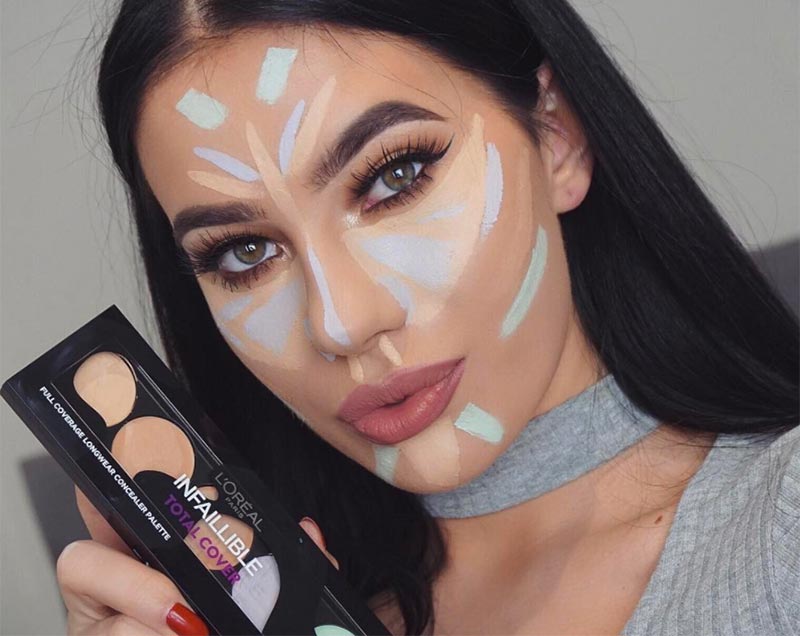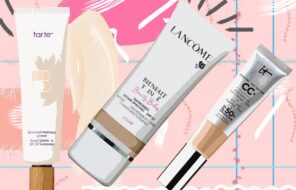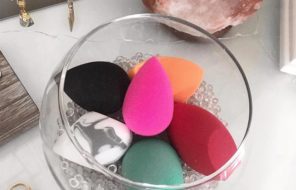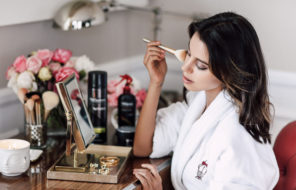Do you know what color correctors are and how to use them correctly? What kind of discoloration do you usually have to hide? Today, I’ll tell you all of the secrets of color correcting makeup. In this article, I go over the theory behind color correcting makeup, I explain which colors work to hide which imperfections, and I give you the best technique for applying color correctors. Enjoy!
In this article:
- What Is Color Correcting Makeup?
- Color Correcting Wheel
- Cancelling out Redness
- Erase Under-Eye Bags
- Brightening up a Sallow Complexion
- The Best Color Correcting Makeup Application Technique
- Color Correcting Makeup Tips & Tricks
What Is Color Correcting Makeup?
Color correctors most frequently take the form of concealers, although color correcting primers, foundations, and powders also exist. Instead of being skin-tone, like your average concealer, they are normally a pale tint of green, yellow, lavender, or peach. When applied over some sort of discoloration on the skin, these color correctors will neutralize the discoloration and eliminate the need for heavy foundation.
Color Correcting Wheel: Let’s Start with Some Color Theory
Any budding makeup artist cherishes their color wheel for two reasons. The first one: it can tell you which colors will stand out next to other colors, making it easy to bring out beautiful blue eyes with a touch of copper, or to create astounding eyeshadow/ blush/ lipstick combinations.
The second reason is that the color wheel is also really important for color correcting makeup. The color correcting wheel shows us how different colors relate to each other.
When it comes to color correcting makeup, we specifically want to look for complementary color pairings. These color pairings, when placed right next to one another, tend to bring each other out. However, when they are placed one on top of the other, they end up neutralizing each other.
How do you figure out these complementary colors? It is super simple! Pick one color, and then draw a straight line from it to the color that is directly across it. You’ll see that green is the opposite of red, yellow is the opposite of purple, and blue is the opposite of orange.
Green Color Correctors
Since green is the opposite of red, green color correctors easily camouflage any redness on the face, be that red acne marks, birthmarks, sunburn, an annoying zit or rosacea.
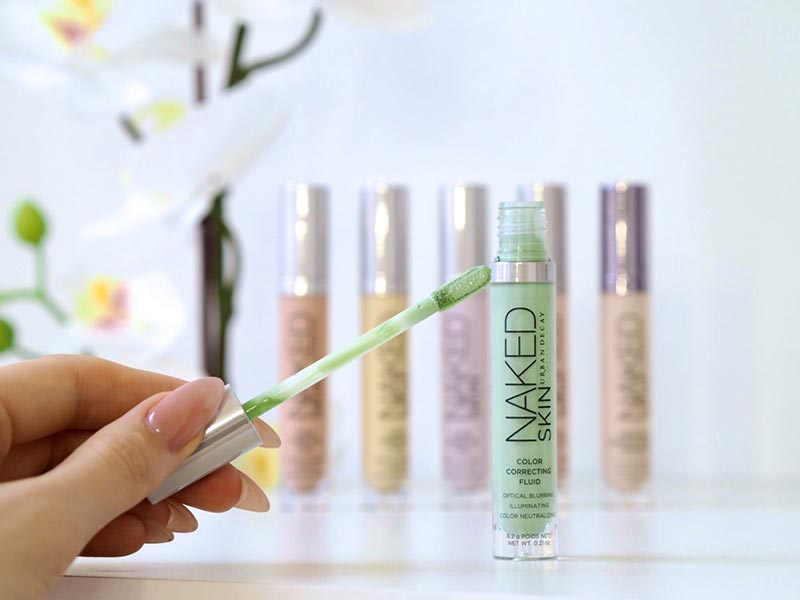
Yellow Color Correctors
Being the opposite of purple, yellow color correctors can cancel out any under-eye dark circles, eye-catching veins and bruises, also perfectly evening out and brightening up your skin tone. Yellow color correctors work perfectly for olive and tan skin tones.
Orange Color Correctors
If you have been reluctant to use face sunscreen every time you walk out the door, and as a result ended up having some dark spots and hyper-pigmentation on your face, orange color correctors can help you even out your skin tone and create that perfect base for your makeup.
Only keep in mind that orange color correctors are meant for those with dark skin tones, while those with lighter skin tones can use them only for contouring or for adding a subtle sun-kissed touch to their makeup.
Peach Color Correctors
While orange color correctors are best for dark skin tones, those with medium skin tones should opt for peach color correctors to hide any blue or purple spots, bruises and dark circles.
Pink Color Correctors
Just like orange and peach color correctors, pink also covers blue-toned spots, but it’s perfect for lighter skin tones. You can use a pink color corrector to camouflage dark circles around the eyes, to eliminate any signs of fatigue from your face and to make your skin look radiant and fresh. Pink color correctors are also great for brightening up olive and sallow skin.
Blue, Purple or Lavender Color Correctors
Being the opposite of yellow, purple or lavender color correctors cancel out yellow spots, eliminate the dullness from your yellow complexion and give a beautiful glow to it.
Cancelling out Redness with Color Correctors for Different Skin Tones
There are multiple types of redness you might experience. Your skin might be red because of acne, because of sensitivity or rosacea, because of broken capillaries, or just because your skin is a little red naturally. Very rarely is the skin truly red, but rather, it is tinted pink.
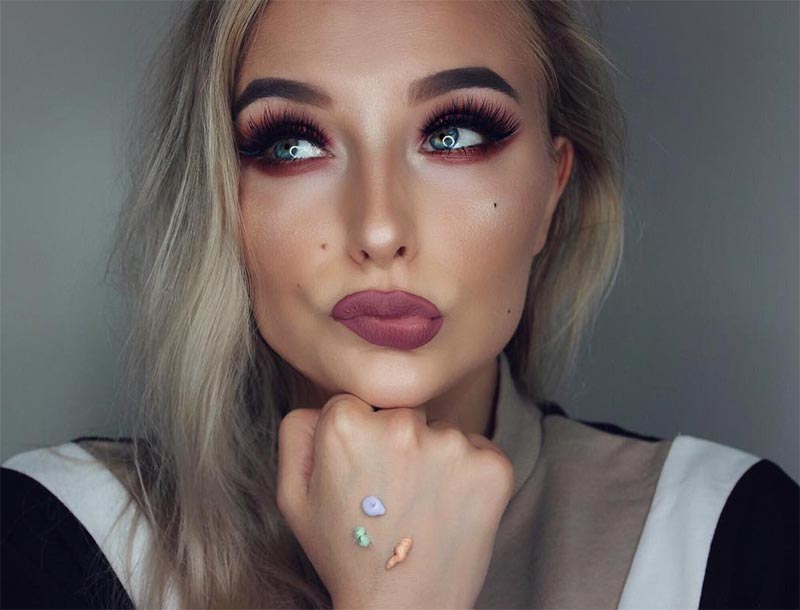
If your skin is pale, especially if it has cool undertones, a pale green concealer is your best bet. Since green is opposite of red (and pale green is the opposite of pink) on the color wheel, it will do a magnificent job cancelling out that redness, leaving your skin looking even and flawless.
When you use green concealer for color correcting, finish of your perfected skin look with a bit of cream or liquid foundation, followed by powder.
For medium to dark skin tones, especially for those with warmer undertones, a true yellow color-correcting concealer might work better than a green one. It will do as good a job of neutralizing the redness in your skin, but it will also blend better into your foundation and the rest of your makeup.
Erase Those Under-Eye Bags with Color Correctors
Dark under-eye circles come in a variety of colors. Have a close look at that pigmentation before choosing the perfect color correcting makeup color.
For purple-based under-eye circles that lean more towards red, you want to use a yellow color-correcting concealer. Yellow will totally neutralize the purple, and will also brighten your under-eye area.
If your skin is a little bit darker, sometimes the yellow over the dark circles can look ashy, so you can blend a bit of orange into your yellow concealer, to get an overall warmer coverage.
For more blue-based under-eye circles, that pale peach color-correcting concealer is your friend, especially if you have pale skin. For those with darker skin, a more saturated orange concealer will work even better because it will match the darkness of your skin and perfectly color correct any discoloration.
You can follow up color correcting makeup on the under eye with just a bit of concealer or foundation, and then a light layer of powder.
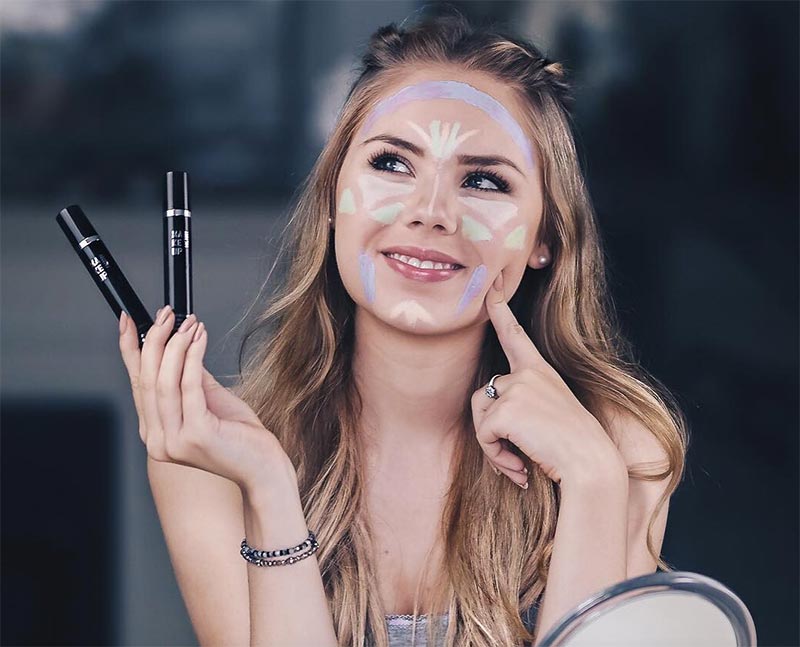
Brightening up a Sallow Complexion with Color Correctors
So lavender color-correcting concealer has to exist for a reason, right? Well, I’ll admit that in nearly 10 years working as a makeup artist, I’ve rarely seen a need to reach for the lavender concealer shade, but I’ll still tell you what it’s all about.
When you color correct purple under-eye circles, you aim for the yellow concealer, so it only follows that a purple based concealer will help with yellow discoloration. This is usually in the case of sallowness, when the skin is overly yellow not in that gorgeous glowy way, but in an unhealthy way.
A lavender primer can do a fantastic job of color correcting without depositing too much color, but you can also blend a bit of heavier lavender concealer into your foundation. Since this calls for the lightest application of color correcting makeup, even a powder foundation is enough to finish off the look.
The Best Color Correcting Makeup Application Technique
No matter which color it is you are color correcting, and no matter where the discoloration is, the application of color correctors itself is about the same.
- Get Your Base
Begin with a cleansed, moisturized, and primed face.
- Map out
Map out the spots on your face that you need to color correct, and lightly apply your color-correcting concealer on them in dots using your fingers, or a concealer brush.
- Blend out
Using either a blending brush, your fingers, or a makeup blender, blend out the color-correcting concealer until it sits over your skin in a very thin layer. Since the job of the colored concealer is to neutralize, rather than cover, you don’t need to build up the coverage. The thinnest layer is more than enough.
- Apply Foundation
Next, use a stippling technique to apply foundation or a concealer that matches your skin tone over the color corrected areas. It is best to use a liquid foundation. You want to tap the foundation onto the skin, in order not to disturb or remove the color correcting makeup.
- Remove Makeup Excess
To remove the excess foundation or to blend it out, gently tap a sponge or a beauty blender over it. The sponge will absorb the excess while keeping all of your layers in tact.
- Contour & Highlight
If you like to contour and highlight with cream products, now is the time.
- Set
Finish off with a dusting of your favorite setting powder, and the rest of your makeup look.
Color Correcting Makeup Tips & Tricks
- Mix your color-correcting concealer with your foundation for a subtler tint and a quicker color correcting makeup application. This technique is perfect for correcting all over the face.
- If you are very pale with a cool undertone to your skin, a lavender concealer can work beautifully as a highlighter.
- If you are looking to correct a subtle color all over your face (like redness or sallowness), a tinted primer might be better than a concealer.
- If you are looking to cover spots here and there, like pimples or hyperpigmentation, then a cream concealer is the best choice.
- For the under eyes, liquid concealers are usually best, because they spread nicely and keep the under-eye area looking healthy and moisturized.
Photos via @laurabadura, Instagram

